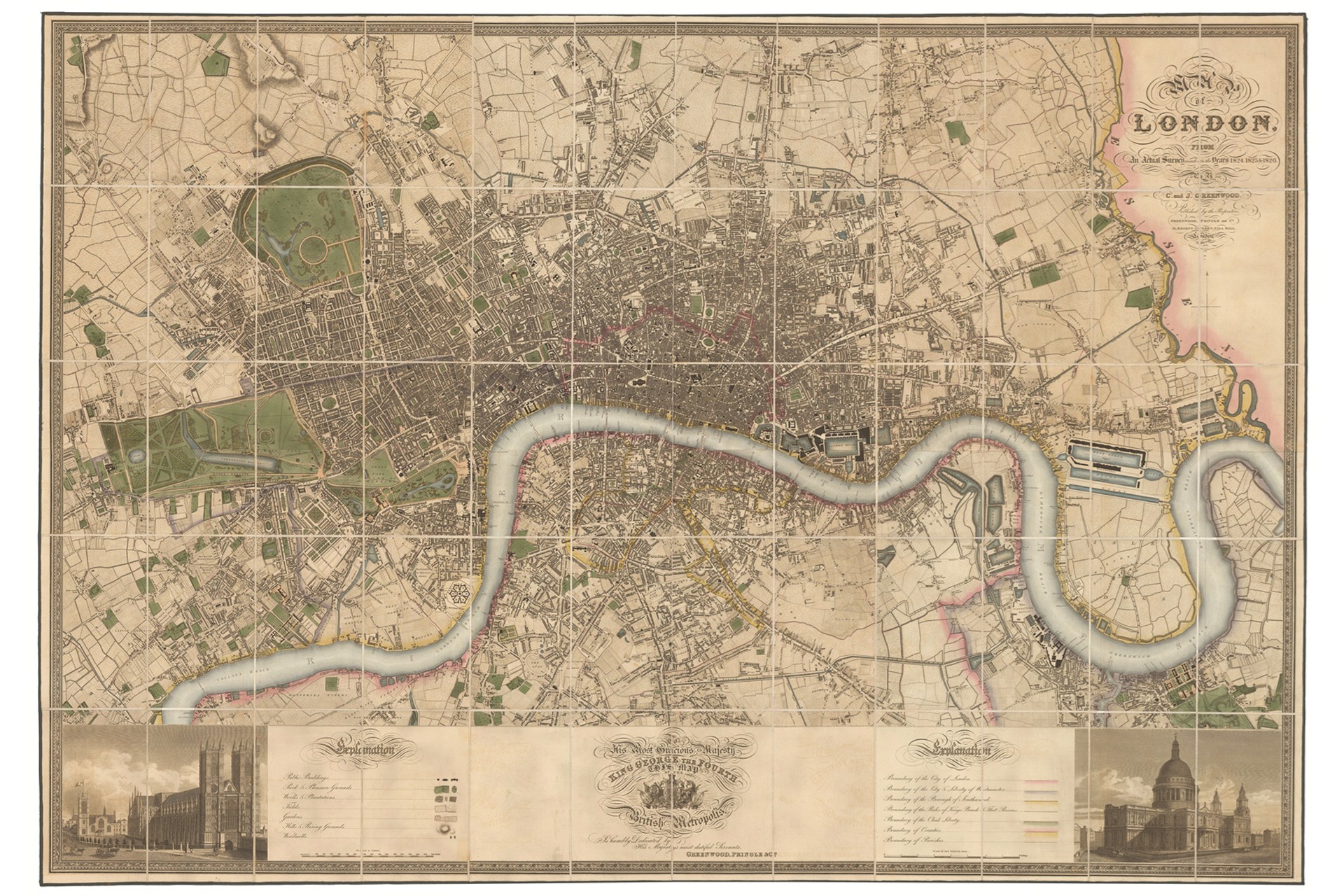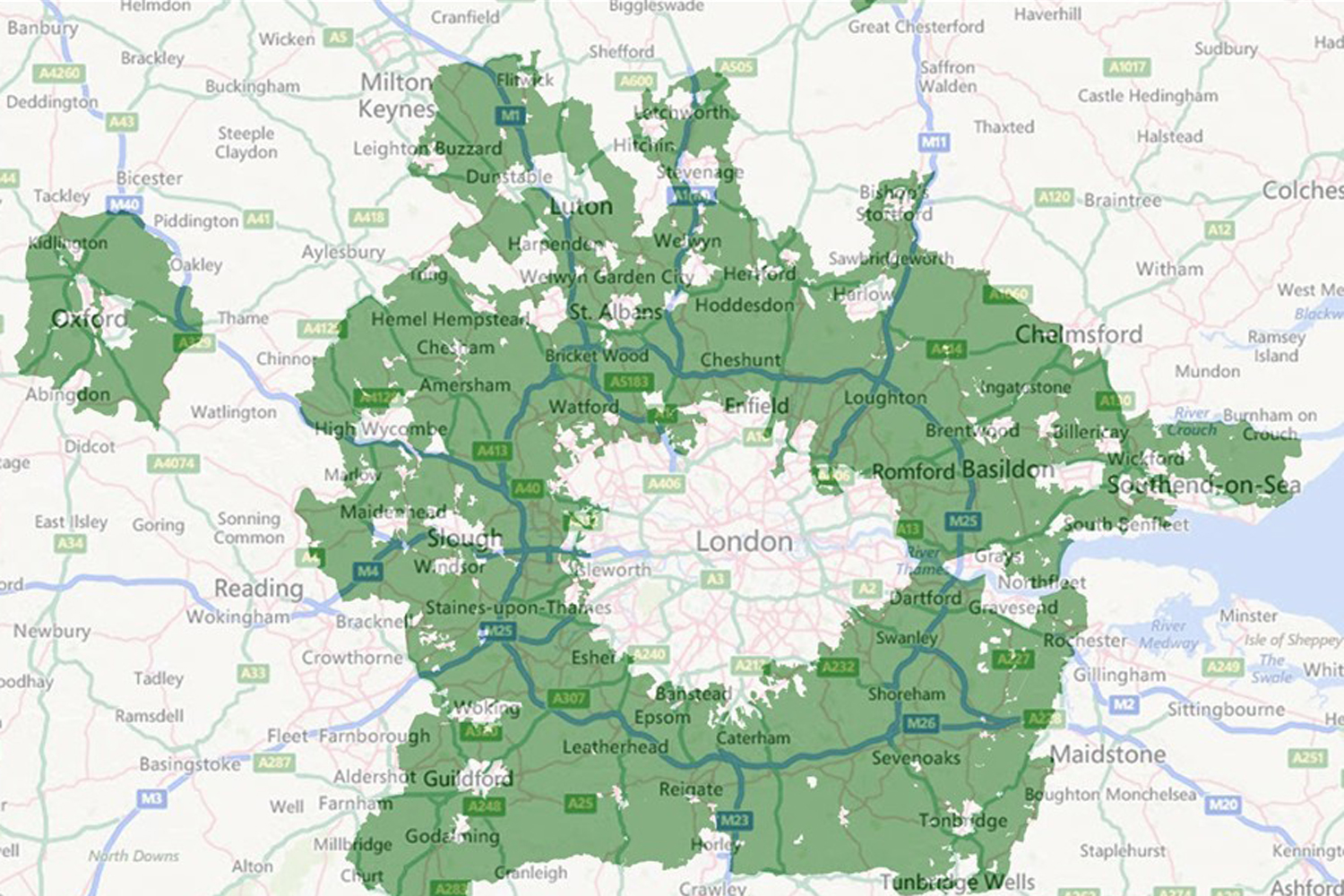Difference between revisions of "Green Spaces in London"
From Londonhua WIKI
(→Pre-Modern Development) |
(→Pre-Modern Development) |
||
| Line 38: | Line 38: | ||
Parks situated in London's fashionable West End eventually became potent elements in London's Image as a capital city, especially Hyde Park, the earliest park to combine successfully the elite pleasures of walking and riding with more popular recreational use. | Parks situated in London's fashionable West End eventually became potent elements in London's Image as a capital city, especially Hyde Park, the earliest park to combine successfully the elite pleasures of walking and riding with more popular recreational use. | ||
| − | [[Image: Greenwood Map 1827.jpg|Greenwood's Map of 1827.<ref>Fowler, L. (2013, June 7). London in vintage maps. Retrieved June 19, 2017, from http://www.cntraveller.com/photos/photo-galleries/vintage-maps-of-london</ref>]] | + | [[Image: Greenwood Map 1827.jpg|x320px|right|thumb|Greenwood's Map of 1827.<ref>Fowler, L. (2013, June 7). London in vintage maps. Retrieved June 19, 2017, from http://www.cntraveller.com/photos/photo-galleries/vintage-maps-of-london</ref>]] |
late 1700s, immense population pressure on the older central area and nearby suburbs was changing the character of a pre-existing green London. | late 1700s, immense population pressure on the older central area and nearby suburbs was changing the character of a pre-existing green London. | ||
Revision as of 09:04, 19 June 2017
Green Spaces in London
by Cole Fawcett
 Hyde Park |
Contents
Abstract
1) a summary of the aims of your project
2) your prior experience with humanities and arts courses and disciplines
3) your major takeaways from the experience
Clearly state a one-sentence statement that summarizes your main objective for this milestone such as "a comparison of the text of Medieval English choral music to that of the Baroque" or it may be a question such as "to what extent did religion influence Christopher Wren's sense of design?"
Introduction
Describe the essence of this project.
Cover what the project is and who cares in the first two sentences.
Cover what others have done like it, how your project is different.
Discuss the extent to which your strategy for completing this project was new to you, or an extension of previous HUA experiences.
Add in some narrative to describe why you did the "thing that you did", which you'd probably want to do anyway.
Section 1: Background
Green Spaces in London
Point out metropolis has 'an astonishing sixty seven square miles of parks, commons, community gardens, garden squares, nature reserves and churchyards to be enjoyed'[1]
variety and quantity as a result of of a long evolutionary process over the course of the 18th into the 20th century.
[2]
Pre-Modern Development
Dependance on continuities from the past. most prestigious green spaces derived from aristocratic and royal residences. Parks situated in London's fashionable West End eventually became potent elements in London's Image as a capital city, especially Hyde Park, the earliest park to combine successfully the elite pleasures of walking and riding with more popular recreational use.

late 1700s, immense population pressure on the older central area and nearby suburbs was changing the character of a pre-existing green London. Older commercialized pleasure gardens reduced in numbers, earlier forms of natural green space disappearing fast <Greenwood's map of 1827> No established right of public access, although commons such as Hampstead Heath and Epping Forest had become recreational areas by customary usage
Innovative period with aristocratic estate developers, villa architects and landscape gardeners leading actor in shaping new forms of landscaped open space.
Aristocratic estate, late 1700s, pioneered the square garden, privately however.
Kew Gardens and botanical and zoological gardens in Regent's Park opened to the public in the 1830s. with the park, a project of the crown estate commissioners, opened fully in the 1840s.
The park's layout, planned by John Nash in 1818, adapted the picturesque design features of the aristocratic country park to an urban setting. Nash's protégé, James Pennethorne, contributed the most to shaping he London examples of an English style of landscaped urban park with ornamental water features.
Victoria Park (1845) and Battersea Park (1860), the largest and most costly, exemplified the concept of the people's park, an important element in the ideology of Victorian liberalism.
[4]
Green Spaces introduction to the Modern era
in regulation of commons and the formation of parks, communal gardens and smaller recreational areas from the 1860s, over a hundred years, diversifying in the inter-war years as metropolitan expansion and changing patterns of recreational activity incited new types of provision. increase in number of commons acquired in the 1870s, proliferation of small open spaces in the 1880-90s, steady progress of park creation from 1880s to 1930s
Metropolitan Green Belt (MGB) embodied a perceived need both to make greater provision for London's recreational space and to protect countryside amenity.
Victoria Park exemplified/exploited an idealized landscape, contrasting commons 'wild and uncultivated condition.
Look at 'The battle for the commons' for Hampstead Heath info (commons)
Parks and Public speech (pg. 50) Parks and Popularity (pg. 52) (LCC) London County Council (pg. 33)
Ideologies, politics and planning in the inter-war years after WWI, representantives of new generation of professional and political interests look to the future of London and quality of life of Londoners. persistent atmospheric pollution punctuated by repeated episodes of smoke fogs call for exposing Londoners to more air and light Along with Educational and popular interest in playing games and keeping fit grew in the inter-war years, called for playing fields and recreational facilities.
Major change from pre-war days: growing recognition of the need for situating open space provision within a planned approach to reconstruction of central London, and more effective control over land. A number of planners and environmental reformers held to a common belief in the possibility of raising the tone of society through recreating a sense of community and civic duty. (The Garden City movement) Sybilla Gurney, "to transform the modern congeries of persons into a real community - to make citizens as well as cities - and to restore the interaction of town and country'.
Independant action of the LCC brought a MGB into being through a system of subsidized land purchases not an inevitable process, but was shaped by political considerations. LCC's intervention was crucial since it meant that London's first Green Belt was brought into being mainly through a complex process of negotiation between the LCC parks committee and out-county authorities responsible for making acquisitions. more on pg. 65
Conclusion activities of governmental agencies in acquiring and controlling open spaces...
A perspective focused on the role of the big players fails to do justice to the range of other interests involved in the social construction of green space: local residents, park and garden users, the staff of parks departments, school authorities, institutions, clubs, and societies, and a varitety of propery interests all had a part to play. Parks are undoubtedly popular adn appealed to a wide range of different users.
This period undoubtedly saw a developing agreement about the value of open space provisions, while illustrating that this was no straightforward consensus but contained problematic elements like saving the London commons. also priorities of policy-makers were frequently subject to competing pressures (MGB). pressures only intensifed in the aftermath of WWII
Modern Green Spaces
The importance of green spaces in towns and cities has been recognized to varying degrees since the 19th century. The apparent value of green spaces in providing an escape from widespread urban air pollution serving as a major driver in creating new parks and green spaces. Over the last 20 years, a rise in interest has taken shape for quality and quantity of green space in urban areas. Three major factors have contributed to this trend: 1) concern about the decline in the quality of green spaces, due largely to low priority in the political agenda on national and local levels, 2) emphasis on the necessity for more intensive development in urban area, informed by "the hight-density 'compact city' " as the model for European cities and where green spaces fit into that, and 3)Improved evidence base supporting the benefits of urban green space, and environmental social and economic value to society.
Brown spaces also need to be taken into account
upsurge reflected as increase in research and professional activity In the UK a number of key documents produced in the last decade has led to government recognition of the vital importance of urban parks and green spaces as key components of urban environments
significance of urban green space on the developing urban environment and urban city life recognised by the Urban Task Force Report and the Urban White Paper, DETR 2000
[6]
Section 2: Deliverable
In this section, provide your contribution, creative element, assessment, or observation with regard to your background research. This could be a new derivative work based on previous research, or some parallel to other events. In this section, describe the relationship between your background review and your deliverable; make the connection between the two clear.
Subsection 1
Gallery
- .jpg
Caption 1
- .jpg
Caption 2
- .jpg
Caption 3
- .jpg
Caption 4
Conclusion
In this section, provide a summary or recap of your work, as well as potential areas of further inquiry (for yourself, future students, or other researchers).
References
- ↑ Billington, J., & Lousada, S. (2003). Introduction. In London's Parks and Gardens (p. ii). London: Frances Lincoln.
- ↑ Nilsson, L., Nolin, C., Deland, M., & Clark, P. (2006). The European city and green space: London, Stockholm, Helsinki and St Petersburg, 1850-2000. Aldershot: Ashgate.,ch. 3
- ↑ Fowler, L. (2013, June 7). London in vintage maps. Retrieved June 19, 2017, from http://www.cntraveller.com/photos/photo-galleries/vintage-maps-of-london
- ↑ Nilsson, L., Nolin, C., Deland, M., & Clark, P. (2006). The European city and green space: London, Stockholm, Helsinki and St Petersburg, 1850-2000. Aldershot: Ashgate.,ch. 3
- ↑ Nilsson, L., Nolin, C., Deland, M., & Clark, P. (2006). The European city and green space: London, Stockholm, Helsinki and St Petersburg, 1850-2000. Aldershot: Ashgate.,ch. 3
- ↑ Swanwick, Carys, Nigel Dunnett, and Helen Woolley. "Nature, Role and Value of Green Space in Towns and Cities: An Overview." 29.2 (2003): 94-106. Web. 14 June 2017.
External Links
If appropriate, add an external links section
